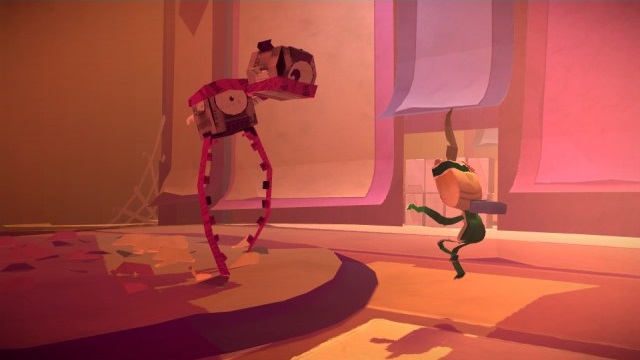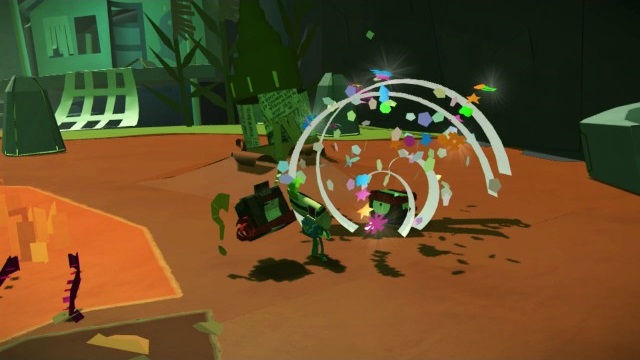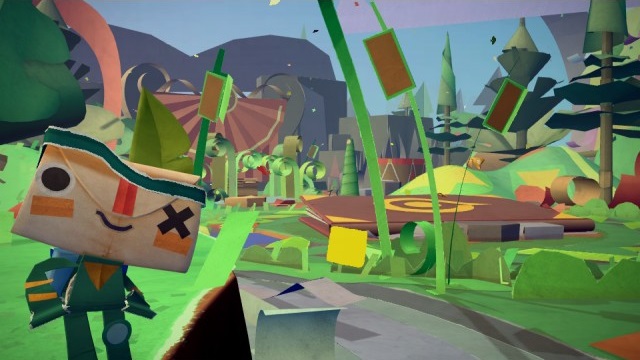Follow the paper trail to the Vita.
Tearaway harkens back to arts and crafts, that wondrous block of time in kindergarten where my art teacher handed me some glue, a pair of scissors, several sheets of colored construction paper, and an environment to destroy the table with my imagination. It's this sense of creative freedom that Media Molecule's new IP attempts to capture, all while leveraging the unique features of the PlayStation Vita.
Ultimately, Tearaway is about whimsy. Every inch of the environment and every character and critter hopping merrily about the field is made out of virtual paper. As your avatar—a messenger with a stick-figure body and an envelope as a head—runs along the prescribed paths, flowers will rise and unfold before your very eyes, raindrops will splatter on the ground in small strips, and miniscule cut-outs float pass like passing dust. Media Molecule could have rested on their laurels and created sparsely-filled landscapes, but the sheer amount of moving paperlike objects makes scenes look like they come straight from an artisan pop-up book.
Complementing the superb presentation is a quirky soundtrack, normally layered in kazoos and clarinets, that fit the unusual graphical style. Sounding somewhere between the music from Banjo Kazooie and Grim Fandango, it fits each setting and event perfectly, especially the lively jig that plays while your character is riding a pig.
The paper theme doesn't fall flat either, combining with the Vita's original features like the internal gyros, touchscreen, and back touch panel. Throughout the messenger's adventure, you'll need to assist by peeling off parts of the environment via the touchscreen to reveal additional platforms, pop your fingers from the ground via the back touch panel to knock out enemy scraps or move large blocks for the messenger to pass through, and tilt the Vita to align platforms for a walkable path. The level progression takes a slow-burn approach, introducing each of these elements in a restricted fashion, before combining all three concepts in the last three levels.
The trouble, though, is that the slow burn takes too long to simmer. Whimsy can only string the gameplay along in the absence of difficulty. This isn't particularly surprising since Tearaway is based on LittleBigPlanet where characters have infinite lives and the experience is meant to have levity and lighthearted humor. But where the purpose of the single-player portion of LittleBigPlanet is to provide an example of possible level designs from the creation suite, all that Tearaway has is the single-player experience, and none of its objectives are particularly challenging.

If you're a completionist who needs to collect every last confetti pick-up (which unlocks customizable parts for the messenger), find every present, and photograph every white object to restore its color, then you might find that part challenging. Achieving 100% on each level is, for what its worth, a test in hide and seek. But the combat against the multiple waves of scraps is ridiculously easy, even without the infinite lives, and the puzzles, albeit innovative, aren't challenging except for a spare few near the end. Collecting confetti to unlock customizable parts, lenses, and filters as well as creating objects out of construction paper can be fun for a while, though you'll get enough confetti to unlock the pieces you want after three levels and the tool for cutting shapes can be imprecise.
Tearaway lacks impetus as well, a strong driving force that moves the story forward apart from having squirrels and scarecrows direct the messenger to where he or she needs to go, well, because he just should. The overarching setup is that the messenger is attempting to deliver a personal note to the face in the sun, which is just you via the Vita's front camera, but the plot is more interesting in its paper windowdressing than in substance. While the ending sequences delve a bit into the existential need for stories and for players, Media Molecule could have gone much deeper. Maybe that's expecting too much from what seems to be a children's game, but the concept behind Tearaway is compelling enough that it could have been as daring as it is whimsical and still be appropriate for all ages.

On that point, a comparison to Journey isn't out of place. Both are around eight hours long, both have quiet but amusing avatars, both use the controller's internal features, and both concern the underlying role of the hero. But Tearaway is better described as a single-player tech demo for the Vita's features that should have a launch title for the handheld rather than an adventure of profound depth.
That said, Tearaway has every right to be a playful, buoyant romp through a paper candyland, and few titles, if any, have integrated the Vita's features as well as it does. Though Tearaway could have extended its final levels to explore creation and identity, its depth isn't paper-thin, and the originality of its presentation alone is unique enough that Vita owners should consider ripping through the game once… but no more than that, or you might give the game its walking papers.
-
Gameplay fully integrates Vita features
-
Whimsical, fantastical papercraft graphics
-
Quirky original soundtrack
-
Story starts off slow but finishes strong
-
Story is also lighthearted but lacks depth
-
Most puzzles and combat not challenging
-
Low replay value and short







